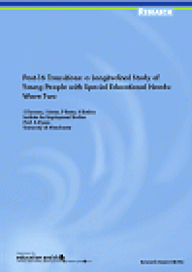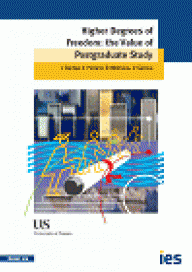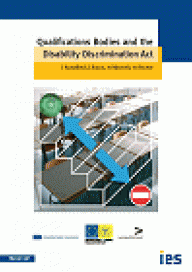Publications
 We author and publish a range of resources to keep you up to date with the latest developments in employment, labour market and human resource policy and practice.
We author and publish a range of resources to keep you up to date with the latest developments in employment, labour market and human resource policy and practice.
All our pdf publications are free to access.
-
📄
Managers as Developers of Others - A Practical Framework for Managers
Hirsh W, Silverman M, Tamkin P, Jackson C | Sep 2004 | Institute for Employment StudiesThis paper outlines how managers can improve their effectiveness in developing others, and covers setting the climate, building a developmental relationship, feedback and focus, delivering development and active career development. It also demonstrates how these elements relate to each other. The paper outlines what managers should not do when developing others.
-

Post-16 Transitions: a Longitudinal Study of Young People with Special Educational Needs (Wave Two)
Dewson S, Aston J, Bates P, Ritchie H, Dyson Prof. A | Sep 2004 | Department for Education and SkillsThis second wave of longitudinal research with young people with special educational needs (SEN) records and tracks their progress as they moved from compulsory schooling to early adulthood. This study reports the experiences of young people two years after they completed statutory schooling.
-

Higher Degrees of Freedom
the Value of Postgraduate Study
Barber L, Pollard E, Millmore B, Gerova V | Aug 2004 | Institute for Employment StudiesThis report presents the key findings of research into the factors that influence postgraduates' choice of study at Sussex University, their study experiences and labour market outcomes. In Autumn 2003 the Institute for Employment Studies (IES) worked with the University of Sussex's Career Development and Employment Centre (CDEC) to conduct the research.
-

Qualifications Bodies and the Disability Discrimination Act
Hurstfield J, Aston J, Mitchell H, Ritchie H | Aug 2004 | Institute for Employment StudiesPart 2 of the Disability Discrimination Act (DDA) 1995 was extended to cover organisations which conferred, renewed or extended a professional or trade qualification. If a provision, criterion or practice of a qualifications body placed a disabled person at a substantial disadvantage in getting or retaining a qualification, then the qualifications body would have a duty to make a 'reasonable adjustment' for a disabled person.
-
📄
Managers as Developers of Others - Main Findings of an IES Research Study
Hirsh W, Silverman M, Tamkin P, Jackson C | Aug 2004 | Institute for Employment StudiesThis paper is based on a study by IES that investigated the behaviour of managers who are good at developing other people in the workplace. This paper contains: characteristics of good and bad development support; situations where good developers make a difference; what motivates good developers of others; enablers and barriers to developign others; the impact of good and bad development support; a framework for managers as developers; some practical suggestions for managers; and information about the research.
-

Tracking learning outcomes
Evaluation of the impact of Ufi
Tyers C, Sinclair A | Aug 2004 | Department for Education and SkillsUfi Ltd was established in 1998 to fulfil its vision of a 'university for industry'. The delivery network was launched in Autumn 2000, with two main products: an independent national learning information and advice service, and a network of learning centres both operated as learndirect. This evaluation follows a strategic initial evaluation in 2002 and tracks the progress of individuals for up to two years from their initial contact with learndirect.
-
📄
The Annual Small Business Survey 2003: UK
Atkinson J, Hurstfield J | Aug 2004 | Small Business ServiceThe Annual Small Business Survey 2003 was a telephone survey of over 8,000 small and medium-sized businesses in the UK. Its main purpose was to gauge the needs and concerns of small businesses and identify the barriers which prevented them from fulfilling their potential.
-

Skills Pay
The Contribution of Skills to Business Success
Tamkin P, Giles L, Campbell M, Hillage J | Aug 2004 | Sector Skills Development AgencyUK productivity has shown a relative decline since the late nineteenth century. This has caused policy makers to seek underlying causes and one of the most durable concerns has focused on skill levels in the UK. The most straightforward comparisons of qualification levels in the workforce for different countries demonstrate that the UK has lower skill levels than our competitor nations. This may therefore be a contributor to the productivity gap.
-
📄
CSR Bibliography
Articles of Interest to the HR Function
Wolfe H | Jul 2004 | Institute for Employment StudiesThis bibliography lists and details some of the literature which is useful to those looking at CSR practices. It is one of a set of three IES research papers about the topic.
-

Socio-Economic Research in the Information Society
A User's Guide from the RESPECT Project
Huws U | Jul 2004 | Institute for Employment StudiesThis guide is designed as an introduction to socio-economic research for the broader community of research users. It will be of use to research funders, research hosts, research evaluators and reviewers, legal professionals providing advice to researchers, employers and managers of researchers and those involved, both as teachers and as students, in research training, as well as the broad community of socio-economic researchers themselves.
